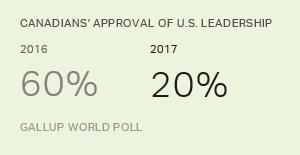WASHINGTON, D.C. -- Perceptions of U.S. leadership worldwide improved significantly from 2008 to 2009. The U.S.-Global Leadership Project, a partnership between the Meridian International Center and Gallup, finds that a median of 51% of the world approves of the job performance of the current leadership of the U.S., up from a median of 34% in 2008.
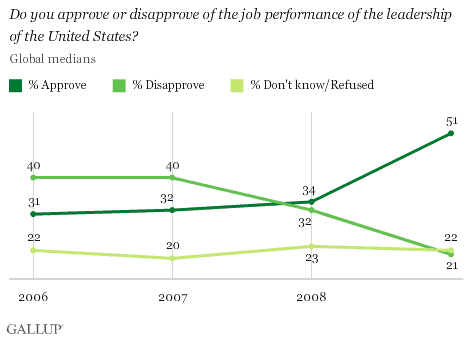
Gallup has asked residents worldwide to rate the leadership of the U.S. since 2005, which enables a comparison of how perceptions of U.S. leadership have changed from the Bush administration to the Obama administration. The global median approval of U.S. leadership remained relatively steady from 2005 to 2008. In 2009, a bare median majority approves of the job performance of U.S. leadership (51%) -- a first since Gallup began asking the question worldwide in 2005.
Significant improvements in sentiment toward U.S. leadership are evident in all four major global regions, with the largest year-over-year increase in approval measured in Europe. Median approval of U.S. leadership increased by 28 percentage points between 2008 and 2009 in this region. A median of 47% approves and a median of 20% disapproves -- the first time disapproval has dropped below 50% in Europe since Gallup first asked the question.
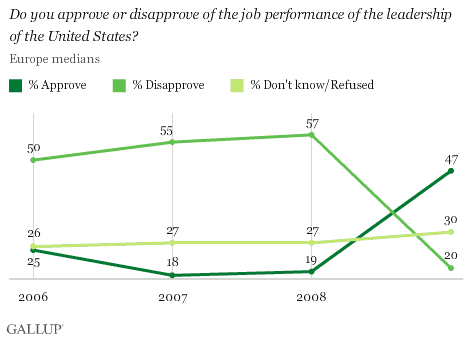
Historically, approval of U.S. leadership has been highest in Africa. However, there is great variability in the region on this issue with approval highest in sub-Saharan Africa and tending to be lower in North African countries. This trend continues in 2009, with a median approval of 83%, which is well above the median approval in other regions. Approval of U.S. leadership ranges from ratings that are higher than 90% in Ivory Coast (94%), Kenya (93%), and Uganda (91%) to lows of 38% in Morocco and 37% in Egypt and Tunisia.
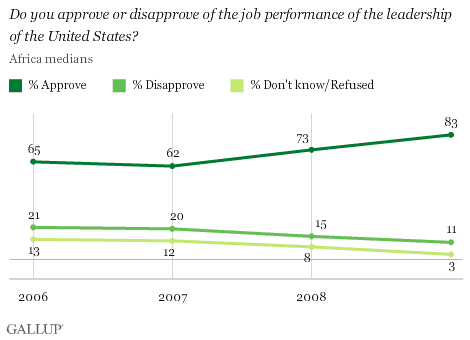
A regional median of 53% in the Americas approves of the job performance of U.S. leadership and a median of 18% disapproves. Approval of U.S. leadership varies from a low of 40% in Bolivia and 42% in Argentina, Ecuador, and Nicaragua to a high of 68% in El Salvador.
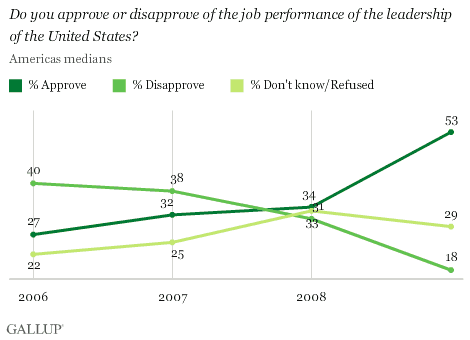
Perceptions of U.S. leadership are more divided in Asia than in any other region. In 2009, a median of more than one-third (38%) say they approve, while 29% disapproved. Pakistanis express the lowest approval of U.S. leadership, at 9%, followed by 14% approval in Iraq, 15% in Syria, and 17% in Vietnam. Approval was highest in Singapore (68%), Japan (66%), Cambodia (64%), Turkmenistan (61%), and Israel (61%).
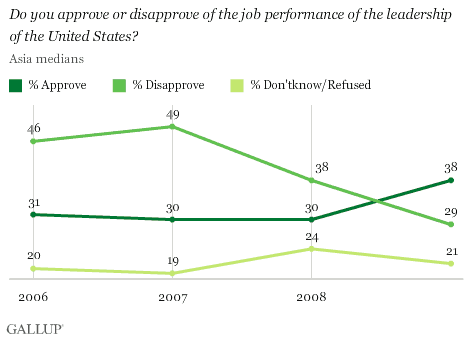
Among the Group of Twenty (G-20) members, approval of U.S. leadership changed significantly in 16 of 17 countries where Gallup collected data before and after the Obama administration took office early last year. In 15 of these countries, approval ratings increased substantially, with increases of 39 points or more in Canada, France, and the United Kingdom. Although sentiment improved significantly in Turkey and Saudi Arabia from 2008 to 2009, majorities in these two countries still disapprove of the job performance of U.S. leadership.
Perceptions of U.S. leadership vary widely within the G-20 member countries. For instance, one in five Russians approve, compared with 87% of South Africans.
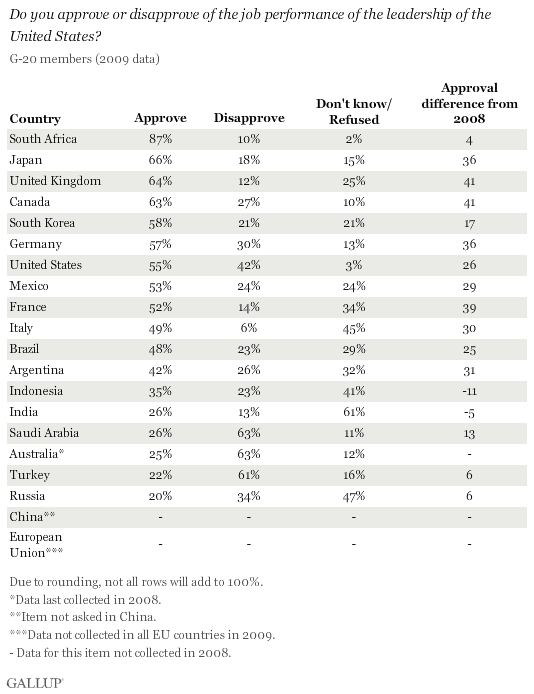
To see all countries worldwide for which 2009 U.S. approval data are available, see the updated map and table on the World Citizens' Views on U.S. Leadership, Pre- and Post-Obama page.
Read the complete findings from the U.S.-Global Leadership Project.
For complete data sets or custom research from the more than 150 countries Gallup continually surveys, please contact worldpollpartners@gallup.com or call 202.715.3030.
Survey Methods
Results are based on telephone and face-to-face interviews with approximately 1,000 adults, aged 15 and older, conducted in 121 countries throughout 2005-2006, 95 countries throughout 2007, 113 countries throughout 2008, and 102 countries throughout 2009. For results based on the total sample of national adults, one can say with 95% confidence that the maximum margin of sampling error ranged from a low of ±2.2 percentage points in Russia to a high of ±5.8 percentage points in Ghana in 2005-2006; a low of ±3.0 percentage points in Belarus, Japan, and Malaysia to a high of ±5.4 percentage points in Ghana in 2007; a low of ±2.5 percentage points in Russia to a high of ±5.8 percentage points in Zambia in 2008; a low of ±2.8 percentage points in Russia to a high of ±5.7 percentage points in Slovenia in 2009. The margin of error reflects the influence of data weighting. In addition to sampling error, question wording and practical difficulties in conducting surveys can introduce error or bias into the findings of public opinion polls.
With some exceptions, all samples are probability based and nationally representative of the resident population aged 15 and older. Exceptions include areas where the safety of interviewing staff is threatened, scarcely populated islands in some countries, and areas that interviewers can reach only by foot, animal, or small boat.
Sample Notes
Algeria: The sparsely populated deep South was excluded. Excluded areas represent less than 10% of the population.
Azerbaijan: Nagorno-Karabakh and territories not included for safety of interviewers. These areas represent less than 10% of the total population.
Bahrain: Non-Arab expatriates were excluded. It's estimated that approximately one-fourth of the adult population is excluded.
Canada: Yukon, Northwest Territories, and Nunavut were excluded from the sample.
Georgia: South Ossetia and Abkhazia were not included for the safety of the interviewers. The excluded area represents approximately 7% of the population.
India: Excluded population living in Northeast states and remote islands. The excluded areas represent less than 10% of the population.
Kuwait: Non-Arab expatriates were excluded. It's estimated that approximately one-fifth of the adult population is excluded.
Moldova: Transnistria (Prednestrovie) was excluded for safety of interviewers. The excluded area represents approximately 13% of the population.
Niger: The Northern part of the country (Agadez region) was excluded because of insecurities. The excluded area represents approximately 5% of the population.
Pakistan: FATA and AJK were excluded. The excluded areas represent approximately 5% of the population.
Palestinian Territories: The sample includes East Jerusalem.
Qatar: Non-Arab expatriates were excluded. It's estimated that more than half of the adult population is excluded.
Saudi Arabia: Non-Arab expatriates were excluded. It's estimated that approximately one-fifth of the adult population is excluded.
Sri Lanka: Excluded areas under conflict in the Northern and Eastern parts of Sri Lanka. The excluded area represents approximately 10% of the population.
Uganda: The Northern region was excluded because of the presence of LRA rebels. The excluded area represents approximately 10% of the population.
United Arab Emirates: Non-Arab expatriates were excluded. It's estimated that more than half of the adult population is excluded.
